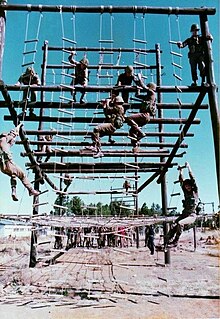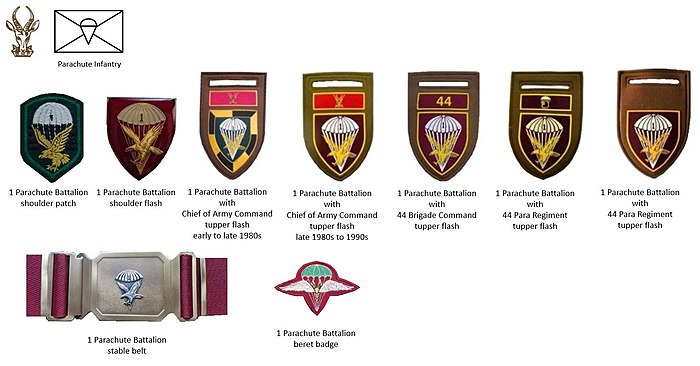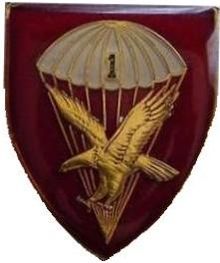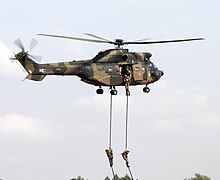|
1 Parachute Battalion
1 Parachute Battalion (Ex Alto Vincimus)[1] is the only full-time paratroop unit of the South African Army. It was founded on 1 April 1961, along with the Parachute Battalion. The name of this unit was changed to Parachute Training Centre after 1998. It was the first battalion within 44 Parachute Brigade until 1999 when the brigade was downsized to a regiment. The battalion has performed many active operations in battle – producing many highly decorated soldiers – in the South African Border War from 1966 to 1989. Their best known action was the controversial Battle of Cassinga in 1978.[2] The unit's nickname "Parabat" is a portmanteau derived from the words "Parachute Battalion".[citation needed] HistoryOriginIn 1960 fifteen volunteers from the SADF were sent to England at RAF Abingdon, the majority to train as parachute instructors, some as parachute-packers and one SAAF pilot in the dropping of paratroopers. These men together with an older unit called 2 Mobile Watch formed the nucleus of 1 Parachute Battalion at Tempe in Bloemfontein in April 1961.  The first paratroopers were Permanent Force men, but soon the training of Citizen Force (similar to the National Guard of the United States) paratroopers commenced. First ActionMembers of 1 Parachute Battalion were the first S.A. Army soldiers to see action after World War II when, in 1966, they participated, with the South African Police, against insurgents in South West Africa.[3] In 1966, members of 1 Parachute Battalion participated in the first action in the war in South West Africa during a heliborne assault on an insurgent base. Thereafter, they were involved in operations in SWA/Namibia, Angola, Zambia, Mozambique and Rhodesia (now Zimbabwe) and elsewhere on an almost constant basis for over 20 years. Organisation under the SADF1 Parachute Bn. was organised as follows:
Development of Sister UnitsFurther battalions were added: 2 Para Bn in 1971 and 3 Para Bn in 1977. Border WarOn the night of 4 June 1974 40 paratroopers from 1 Parachute Battalion B Company jumped into Angola as support for a group of Recce's on a counter insurgency mission against SWAPO in southern Zambia. Following this operation Recce Lieutenant Freddie Zeelie was killed on 23 June 1974 and became the first SADF soldier killed in combat during a contact with insurgents in southern Angola during the border war era. In 1974 and 1975 1 Parachute Battalion operated along the Angolan border with S.W.A; along the Caprivi Strip; a platoon jumped near Luiana (September 1975), Angola to relieve a group of "Bushmen" trapped by a SWAPO force; and 3 platoons Joined Operation Savannah at Sá da Bandeira the day after the airport was taken (October 1975). The two platoons withdrew in February/March Operation Savannah during the Angolan Civil War in July 1975 when 1 string of 1 Parachute Battalion were flown to Ondangwa and travelled by Unimog to Ruancana on the northern border of SWA at Ruacana and Santa Clara in Angola to relieve two Portuguese communities trapped by the MPLA. The Para BrigadeWith the coming of 44 Parachute Brigade in April 1978, under the leadership of Brigadier M J du Plessis and Colonel Jan Breytenbach, a co-founder of the brigade. it became a powerful force. The first large airborne exercise of the Parachute Battalion Group took place in 1987 in the Northwestern Transvaal (now North West Province). With the eventual disbanding of 44 Parachute Brigade its full-time personnel were moved to Bloemfontein and incorporated into the 1 Parachute Battalion Group. New TechniquesIn 1986, the unit embarked on its first HALO/HAHO (High altitude Low Opening/High Altitude High Opening) course in Bloemfontein. This would enable the troops to drop into enemy territory from aircraft following commercial routes. Under the SANDFIn 2001 battalion personnel formed the spearhead of the South African Protection Support Detachment deploying to Burundi.[4] In 2012, 1 Parachute Battalion participated in the South African military assistance to the Central African Republic operation, where the unit suffered 13 killed, with 27 injured and one missing in action in an ambush conducted by Séléka rebels.[5] In 2014 it was announced that 1 Parachute Battalion would receive Battle Honours for this operation.[6] In 2013, the battalion contributed one company, under command of Major Vic Vrolik, to the FIB which fought a number of engagements in the DRC.[7] Training 1 Parachute Battalion is the sole military parachute training institution in South Africa, with its parachute School being responsible for all training. The school has had only four fatalities in its existence. 1 Parachute Battalion is a full-time unit which in addition to parachute training also conducts force training to recruits inducted into the unit and other units in the South African Army. The average age ranges in the mid-twenties. The selection and training of paratroops is rigorous to ensure a standard of combat efficiency is retained at a high level. RecruitmentMembers of 1 Parachute Battalion visit the various battalions each year early in the training cycle to look for volunteers. These must then pass a physical test at their unit prior to appearing before a selection board, which examines their character and motivation. Initial evaluationTo give would-be members the endurance and the fitness they will need for operations in the harsh African conditions, the instructors of 44 Parachute Brigade place particular emphasis on basic physical training. Soldiers volunteering for service with the parachute forces first undergo a battery of medical tests – similar to that for flying personnel – before setting off on a 5 kilometres (3.1 mi) timed run. Before they can recover their breath, they tackle the second test: 200 metres (0.12 mi) run in which each man carries a comrade on his back. The applicants are then put through various psychological and physical tests – though these are usually well within the reach of anyone with sufficient motivation and willpower. The real ordeal will then start: for four long months, the recruits Bats will endure forced marches, physical exercises, shooting sessions and inspections – all this barracked by the screams of their eagle-eyed instructors. The South African paratroop instructors, like their British counterparts, enforce strict discipline. For example, trainees always take their grooming kit along with them on 30 kilometres (19 mi) marches and at dawn, when back at the base with aching bones, devote whatever little time is left they have to rest to 'spit and polish'. Those who are accepted are then transferred to 1 Para, where they first complete the normal three-month basic training course, with some differences: PT three times a day, no walking in camp under any circumstances and a 10 to 15 kilometres (6.2 to 9.3 mi) run to end each day. 20 kilometres (12 mi) runs carrying tar poles; car tyres attached to the candidates by a long rope; or the dreaded 25 kilograms (55 lb) concrete slab that has to be carried everywhere the candidate goes. Some 10 to 20 percent drop out during this phase, returning to their original units. All this builds up to what is called the koeikamp ('cow camp'). It is 3 days of the ultimate challenge of physical and psychological endurance. The would-be paratroops get a 24-hour ration pack or "rat pack" for the duration of the selection. During these days, they are given several tasks to perform in an allocated time: Several 20 to 30 kilometres (12 to 19 mi) Night marches/runs with 25 kilograms (55 lb) bergens, boxing, 75 kilograms (165 lb) stretcher run over 20 kilometres (12 mi), digging trenches and the carrying of artillery canisters over 10 kilometres (6.2 mi) during a timed run are just a few of the tasks that has to be completed. On top of all this the candidates are out in the African bush with no showers, hot meals or beds after each gruelling day. Each year the sequence of what "tests" will be done to get the strongest out of the "wannabees" changes, so it comes as quite a surprise each year. Due to lack of sleep, hunger and extreme physical tasks many of the men give up. After all the above tests, the few remaining soldiers head back to camp where they have to complete an obstacle course called the "Elephant". Some foreign Elite soldiers claimed this to be one of the hardest bone breaking obstacle courses ever.[2] Again, this is a timed exercise, which has to be completed several times, it is also done with full battle kit. Again the instructors are looking for any hesitant students during the high obstacles and underwater swim through a narrow tunnel. At the end of the "Elephant" several more students drop out due to injury or not completing the course in the required time. At this point the course has been completed. However, there is always the 'bad surprise" which has historically become part of the Selection Phase. After a six-month ordeal, the selected few (about 40% of the original intake), make the 12 jumps required to obtain their wings. During this time, the chances of being disqualified are still very high. This phase is followed by some advanced individual training, during which such subjects as advanced driving, demolitions, tactics and patrolling, unarmed combat, survival skills, escape and evasion, aspects of guerrilla warfare, tracking, raiding, counterinsurgency operations, fast rope skills, ambush and anti-ambush techniques and foreign weapons and techniques are covered. Their instructors, however, always find that something is left to be desired with the inspection which invariably follows. To harden their muscles, trainees are made to carry a telegraph pole for two days, at a rate of 20 kilometres (12 mi) daily. Back at base, the 'marble', a stone weighing about 25 kilograms (55 lb) which the soldier must carry wherever he goes, is used as a substitute for the same purpose. The detailed training programme is listed below:    Basic training – 10 weeks
Parachute qualification training – 5 weeks
Individual training – 8 weeks
Conventional warfare training – 10 weeks
Counter-insurgency (COIN) training – 9 weeks
Active operational duty
Other Training
Leadership
InsigniaPrevious Dress Insignia  Battle Honours
Notes
References
|
|||||||||||||||||||||||||||||||||||||||||||||||||||||||||||||||||||||||||||||||||||||||||||||||||||||

